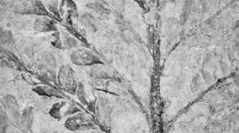

 Comptes Rendus Palevol
8 (2-3) - Pages 155-165
Comptes Rendus Palevol
8 (2-3) - Pages 155-165The earliest axes exceeding 10 cm in diameter, and presumed to represent small trees, evolved in the Middle Devonian (about 395 million years). They belong to the Cladoxylopsida, a basal group of ferns s.l. lacking leaves. These trees grow mainly vertically, the trunk producing short-lived branches at the top and adventitious roots at the base. They show a dissected vascularisation, and little if any secondary tissues. The Archaeopteridales that evolved at the end of the Middle Devonian, have leaves, abundant wood, and secondary phloem. Growth in the aerial and subterranean parts is tri-dimensional and extensive. Contrary to these two strategies that evolved several times independently during the history of terrestrial plants, that exhibited by the lycophytes became extinct at the end of the Mesozoic. These trees are characterized by a symmetrical development of the aerial and underground parts that branch dichotomously. Branch production by the trunk is relatively late. These trees show a narrow vascular system and a wide cortex.
Devonian, Paleozoic, Terrestrial plants, Cladoxylopsida, Archaeopteridales, Lycophytes